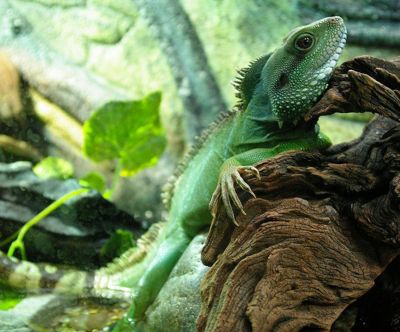Lizard Classification
Jump to navigation
Jump to search
| This article is still under construction. |
Lizard Classification Table
| Suborder | Infraorder | Family | Common Name | Genera | Species |
|---|---|---|---|---|---|
| Sauria | Iguania | Agamidae | Water Dragons | 53 | 300 |
| Iguanidae | Iguanas | 55 | 650 | ||
| Chamaeleontidae | Chameleons | 4 | 85 | ||
| Gekkota | Gekkonidae | Geckos | 85 | 800 | |
| Pygopodidae | Snake lizards | 1 | 31 | ||
| Scincomorpha | Lacertidae | Wall and sand lizards | 25 | 200 | |
| Teiidae | Tegus, whiptails | 39 | 227 | ||
| Xantusiidae | Desert night lizards | 1 | 16 | ||
| Scincidae | Skinks | 85 | 1275 | ||
| Cordylidae | Girdle-tailed lizards | 10 | 50 | ||
| Dibamidae | Blind lizards | 1 | 4 | ||
| Anguinomorpha | Xenosauridae | Crocodile lizards | 1 | 4 | |
| Anguidae | Anguids | 8 | 75 | ||
| Helodermatidae | Beaded lizard, Gila Monster | 1 | 2 | ||
| Varanidae | Monitors | 1 | 31 | ||
| Lanthanotidae | Borneo earless lizard | 1 | 1 |
- For more information on the lizard taxonomy, seeLizard Taxonomy and Identification.
Families
Agamidae
- Family of lizards of the old world
- Acrodont dentition
- Includes the agama (Agama agama), frilled lizard (Chamydosaurus kingii), water dragon (Psysignathus cocincinus), Egyptian spiny-tailed lizard (Uromastyx aegyptius) and the sail-fin lizard (Hydrosaurus pustulatus)
Iguanidae
- Family of lizards in the new world and a few species in the Indian Ocean region
- Pleurodont dentition
- Includes the green iguana (Iguana iguana), the green anole (Anolis carolinensis), basilisks (Basiliscus spp.), horned lizards (Phrynosoma spp.) spiny lizards (Sceloporus spp.) and West Indian rock iguanas (Cyclura spp.)
Chamaeleontidae
- Old world or true chameleons
- Anatomical differences from other lizards may include astonishingly long tongues, ability for colour change, oppositely opposable digits and prehensile tails.
- Generally viviparous
Gekkonidae
- Geckos
- Large and diverse family which have colonised all tropical areas and extended into temperature regions
- Primarily nocturnal insectivores
- Anatomical differences from other lizards may include toe-pads, eyelids that have fused and are transparent as in snakes and eyes that move independently and are usually large
- When subjected to daylight the pupils contract to a narrow slit with a series of pinholes
- Generally oviparous with one to two eggs laid but some are viviparous
- Three subfamilies are Eublepharine (no toe-pads), Sphaerodactylinae and Gekkoninae
- Includes the commonly kept leopard gecko (Eublepharis macularius)
Pygopodidae
- Includes snake lizards (Lialis spp.) and the scalyfoot (Pygopus spp.) which are without forelimbs and their hindlimbs are reduced to flaps of skin
Lacertidae
- Wall or sand lizards of the old world
- Insectivorous
- All oviparous except the viviparous lizard (Lacerta vivapara)
- Includes the oscellated green lizard (Lacerta lepida), rock lizard (Lacerta saxicola)
Teiidae
- New world equivalents of the Lacertidae
- The smaller are insectivorous and the larger carnivorous
- Includes the whiptails and racerunners (Cnemidophorus spp.), jungle runners (Ameiva spp.) and tegus (Tupinambis spp.)
Xantusiidae
- Desert night lizards
- Xantusia spp.
Scincidae
- True skinks
- Little sexual dimorphism
- Includes the blue-tongued skink (Tiliqua spp.), prehensile-tailed skink (Corucia zebrata), five-lined skink (Eumeces fasciatus) and the casqueheads (Tribolonotus spp.)
Cordylidae
- Zonures or girdle-tailed lizards
- All require very hot, dry conditions
- Includes Cordylus spp.
Dibamidae
- Blind lizards
- Dibamus and Anelytropsis spp.
Xenosauridae
- Consists of the Chinese crocodile-tailed lizard (Shinisaurus crocodiluris) and the new world xenosaurs (Xenosaurus spp.)
Anguidae
- Long and snake-like in form
- In America, Asia, Africa and Europe but species are not numerous
- Both oviparous and viviparous species, both diurnal and nocturnal species and generally terrestrial
- Insectivorous or carnivorous
- Includes slow-worm (Anguis fragilis), alligator lizards (Elgaria spp.), glass lizards (Ophisaurus spp.) legless lizards (Annelia spp.) and the sheltopusik (Ophisaurus apodus)
Helodermatidae
- Two species that are the only venomous lizards
- Gila monster (Heloderma suspectum) and the Mexican beaded lizard (Heloderma horridum)
Varanidae
- Monitor lizards
- Mostly large powerful predators or carrion eaters
- Includes the savannah monitor (Varanus exanthematicus), Nile monitor (Varanus niloticus) and the Komodo dragon (Varanus komodoensis)
Lanthanotidae
- Monotypic family
- The Bornean earless lizard (Lanthanotus borneensis)
